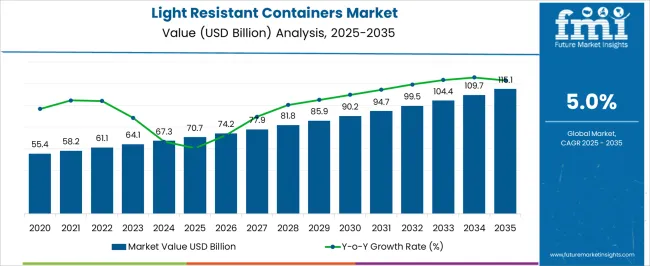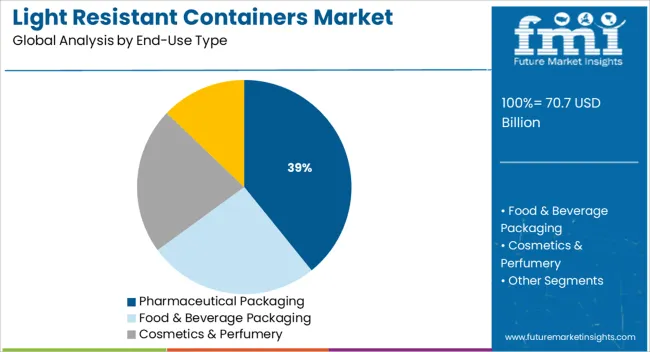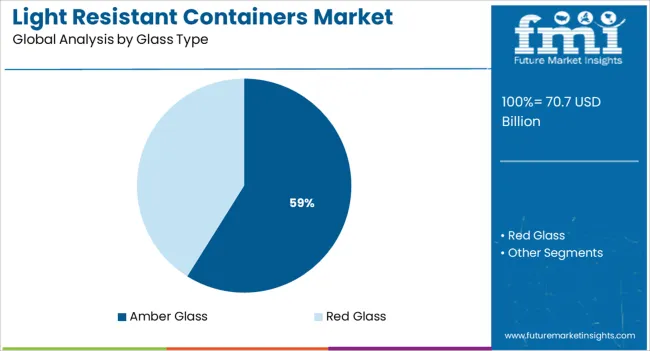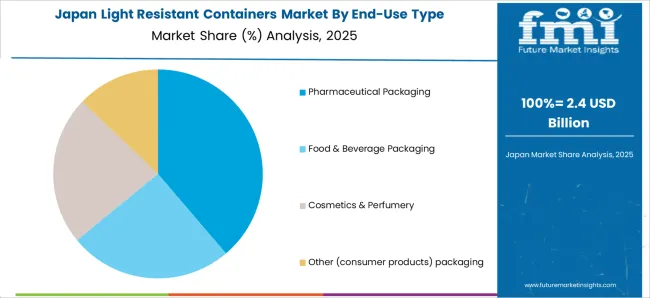The Light Resistant Containers Market is estimated to be valued at USD 70.7 billion in 2025 and is projected to reach USD 115.1 billion by 2035, registering a compound annual growth rate (CAGR) of 5.0% over the forecast period.

| Metric | Value |
|---|---|
| Light Resistant Containers Market Estimated Value in (2025 E) | USD 70.7 billion |
| Light Resistant Containers Market Forecast Value in (2035 F) | USD 115.1 billion |
| Forecast CAGR (2025 to 2035) | 5.0% |
The light resistant containers market is experiencing a steady rise, primarily driven by the expanding pharmaceutical and nutraceutical sectors that demand optimal protection against photodegradation. The growing focus on product stability and extended shelf life, particularly in temperature and light-sensitive formulations, is contributing to the market’s positive trajectory.
Regulatory bodies across multiple regions have been enforcing stringent packaging requirements to maintain drug potency and prevent contamination, which has amplified the demand for light-resistant packaging formats. Material innovations and container manufacturing improvements are enabling enhanced barrier properties, recyclability, and labeling flexibility.
The increasing production of biologics and specialized injectables, along with global vaccination campaigns and aging population trends, are further accelerating the use of containers designed to limit UV and visible light exposure In the near future, collaboration between pharmaceutical firms and packaging innovators is expected to drive next-generation containers with improved optical shielding, making light resistant solutions a standard across multiple application environments.
The market is segmented by End-Use Type and Glass Type and region. By End-Use Type, the market is divided into Pharmaceutical Packaging, Food & Beverage Packaging, Cosmetics & Perfumery, and Other (consumer products) packaging. In terms of Glass Type, the market is classified into Amber Glass and Red Glass. Regionally, the market is classified into North America, Latin America, Western Europe, Eastern Europe, Balkan & Baltic Countries, Russia & Belarus, Central Asia, East Asia, South Asia & Pacific, and the Middle East & Africa.

The pharmaceutical packaging segment is projected to account for 39.2% of the total revenue share in the light resistant containers market in 2025, reflecting its dominant role in the industry. Growth in this segment is being driven by the critical need to protect drug formulations from photodegradation, which can compromise chemical stability, potency, and safety.
The increase in production of light-sensitive drugs, including antibiotics, biologics, and vitamins, has necessitated packaging solutions that comply with regulatory guidelines on light transmission. Adoption has also been supported by the rise in sterile and injectable therapies that require container clarity and durability, without sacrificing protective qualities.
Manufacturers have increasingly relied on pre-tested light resistant containers to meet global standards set by regulatory authorities such as the USP and EMA With growing emphasis on patient safety, contamination prevention, and long-term storage, the pharmaceutical sector continues to lead the demand for advanced light resistant packaging technologies.

Amber glass is expected to represent 58.9% of the total revenue share in the light resistant containers market in 2025, making it the most widely used glass type. The segment’s prominence is being reinforced by amber glass’s superior light-blocking capabilities, particularly in the ultraviolet and visible light spectrum ranges.
It has become the preferred choice across regulated industries due to its proven effectiveness in preventing photochemical reactions that could alter sensitive product compositions. Amber glass offers a cost-effective, chemically inert, and easily moldable packaging solution, making it suitable for high-volume pharmaceutical and chemical applications.
Additionally, its recyclability and resistance to leaching have aligned well with sustainability mandates being pursued by packaging and healthcare industries alike The ability to meet rigorous quality specifications for light transmission testing, while maintaining compatibility with automated filling and labeling systems, has strengthened the position of amber glass in modern container systems.
Light resistant containers keep the content safe from the effect of light owing to the material’s scientific properties of which it is composed, including any type of coating applied to it.
A transparent light resistant container is widely used to store the medicinal agents includes capsules, tablets, etc. Light resistant containers are used in pharmaceutical industry to protect them from photochemical deterioration.
Light resistant containers help to reduce light transmission adequately to protect any light sensitive medicinal product. In addition, the Light resistant container should meet the USP (US. Pharmacopeial Convention) reference standard to accept the light transmission limit at any wavelength of light between 290 and 450 nm.
Light resistant containers also have high demand in food and beverages industry. Furthermore, red glass and amber glass are more effective to resist the sunlight to protect the contents.
The key driving factor of global light resistant containers market is rising demand for green pure and sustainable food & beverage packaging among consumers. Light resistant containers remain chemically inert, pure and safer to be used, their demand and popularity and demand is significantly rising among consumers.
Technological advancement in light-resistant containers is also a major driving factor of global light resistant containers market, owing to protect the contents from ultraviolet rays, deterioration and getting fade. The rapidly growing pharmaceutical industry will help to grow the light resistant containers market across the globe due to high usage of medicines across the globe.
Furthermore, significant growth in chemical industry and cosmetics industry are also the major driving factors for the light resistant containers market across the globe, owing to the high consumption of cosmetics among consumers. Significant growth in the healthcare and packaging industry acts as the key driver in the global light resistant containers market.
In addition, the recyclable property of light resistant containers is another major factor which makes it the most preferred choice of packaging and helps to grow the light resistant containers market over the forecasted period.
The key restraining factor of global light resistant containers market is to meet the USP reference standard due to a high protection of content from an effect of light. Light resistant containers embedded with smart devices is the key trends of global light resistant containers market.
Based on the geographies, global light containers market is segmented into seven regions globally such as Eastern Europe Western Europe, North America, Latin America, Asia-Pacific excluding Japan, Japan, and Middle East & Africa.
Among the regions as mentioned above, North America accounts the high market share in light-resistant containers market across the globe due to a high demand for light resistance packaging for medicinal contents.
Asia-pacific is predicted to witness high growth rate in the global light resistant containers market, attributed to rapid growth of pharmaceutical industry in this region.

In addition, Japan is also a high growing market for cosmetics along with pharmaceutical industry which will help to grow the light resistant containers market across the globe. The Middle East and Africa region are one of the highest oil producing region.
So, MEA region is estimated to see a positive growth rate in light-resistant containers market across the globe, owing to a high demand for light-resistant containers for chemical along with the petrochemical industry.
Furthermore, Western Europe is also estimated to a positive growth rate in global light containers market due to high demand for light resistant packaging in pharmaceuticals and chemical industry.
The research report presents a comprehensive assessment of the market and contains thoughtful insights, facts, historical data, and statistically supported and industry-validated market data. It also contains projections using a suitable set of assumptions and methodologies.
The research report provides analysis and information according to categories such as market segments, geographies, types, technology and applications.
Global light resistant containers market can be segmented by material type, end-use industry and region type:
The global light resistant containers market is estimated to be valued at USD 70.7 billion in 2025.
The market size for the light resistant containers market is projected to reach USD 115.1 billion by 2035.
The light resistant containers market is expected to grow at a 5.0% CAGR between 2025 and 2035.
The key product types in light resistant containers market are pharmaceutical packaging, food & beverage packaging, cosmetics & perfumery and other (consumer products) packaging.
In terms of glass type, amber glass segment to command 58.9% share in the light resistant containers market in 2025.






Full Research Suite comprises of:
Market outlook & trends analysis
Interviews & case studies
Strategic recommendations
Vendor profiles & capabilities analysis
5-year forecasts
8 regions and 60+ country-level data splits
Market segment data splits
12 months of continuous data updates
DELIVERED AS:
PDF EXCEL ONLINE
Light Therapy Market Forecast and Outlook 2025 to 2035
Light Rail Traction Converter Market Size and Share Forecast Outlook 2025 to 2035
Light Management System Market Size and Share Forecast Outlook 2025 to 2035
Lightweight Corrugator Modules Market Size and Share Forecast Outlook 2025 to 2035
Lightening and Whitening Creams Market Analysis - Size and Share Forecast Outlook 2025 to 2035
Lightweight Automotive Body Panels Market Size and Share Forecast Outlook 2025 to 2035
Lightening / Whitening Agents Market Size and Share Forecast Outlook 2025 to 2035
Light Control Switch Market Size and Share Forecast Outlook 2025 to 2035
Lightweight Handheld Cordless Vacuum Cleaner Market Size and Share Forecast Outlook 2025 to 2035
Light Setting Spray Market Size and Share Forecast Outlook 2025 to 2035
Light-Activated Anti-Pollution Skincare Market Analysis - Size and Share Forecast Outlook 2025 to 2035
Lighting As A Service Market Size and Share Forecast Outlook 2025 to 2035
Light Duty Truck Market Size and Share Forecast Outlook 2025 to 2035
Light Commercial Vehicle Market Size and Share Forecast Outlook 2025 to 2035
Light Emitting Diode (LED) Backlight Display Market Size and Share Forecast Outlook 2025 to 2035
Light Control Switches Market Size and Share Forecast Outlook 2025 to 2035
Lighting as a Service (LaaS) Market Size and Share Forecast Outlook 2025 to 2035
Light Field Market Size and Share Forecast Outlook 2025 to 2035
Lighting Product Market Size and Share Forecast Outlook 2025 to 2035
Light Field Cameras Market Size and Share Forecast Outlook 2025 to 2035

Thank you!
You will receive an email from our Business Development Manager. Please be sure to check your SPAM/JUNK folder too.
Chat With
MaRIA